RELATED CONTENT

Presenting The Benefits
Many opticians present the PAL technology story in everyday terms. Describing the difference between the PALs he fits today versus a few years ago, Marty Bregman, FNAO, an optician at Mr. Specs Opticians in Lynn, Mass., tells patients, “It’s like watching HD TV rather than regular TV.”
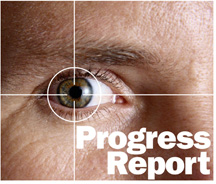 Bregman’s first choice in PALs is the Varilux Physio, which is digitally surfaced with the use of Essilor’s patented “Wavefront Advanced Vision Enhancement” or W.A.V.E. Bregman also fits the Zeiss GT2, which is digitally surfaced with a total aberration control process and with wearer ergonomics factored into the finished lens design.
Bregman’s first choice in PALs is the Varilux Physio, which is digitally surfaced with the use of Essilor’s patented “Wavefront Advanced Vision Enhancement” or W.A.V.E. Bregman also fits the Zeiss GT2, which is digitally surfaced with a total aberration control process and with wearer ergonomics factored into the finished lens design.
Gary Feigelman, optician/owner of Island Vision in Valley Stream, N.Y. said, “We don’t talk much about technology, we present benefits.” Feigelman is a second-generation optician who sees an increasing portion of his business in fitting premium PALs--both first-time fits and trade-ups in quality of vision. The key to success, he said, is recognizing the type of presbyope who will appreciate the nuances in improved vision and is willing to pay for a premium lens that delivers it.
 |
| The staff at Mr. Specs Opticians in Lynn, Mass. are experts at explaining PAL benefits to patients.Pictured (l to r) are Al Piccole, owner/optician, Usana Wu, OD and Marty Bregman, optician, FNAO. |
“I pick and choose who I present to and who I think would be receptive,” he explained. “That’s not everybody. If lenses cost $500 or $600, someone has to appreciate what the product is going to do.”
Johnson also minimizes the tech talk about PALs. “It depends on the patient, but I usually don’t get into the specifics of asphericity,” he said. “I’ll talk to them about more natural vision and about lenses that are thinner and lighter, and they understand that.” He presents PALs with three or four tiers in pricing, varying with high index materials and lens designs, and believes that “being a straight shooter” in pricing is best for the patient.
Mike Tiernan’s philosophy in presenting PALs to his customers is, “Why not start with the best?” That best is the Varilux Physio 360, he said, both for emerging presbyopes and existing presbyopes looking to move up. “We don’t even talk about some of the problems of old,” he said, in reference to issues like peripheral aberrations. “We talk about clarity of vision, the ability to see clearly at all distances and peripherally. And we say that this lens is like going to an automatic transition versus the stick shift.”
A Boon for Opticians
While an explanation of technologies like wavefront, freeform or digital surfacing may be interesting to some presbyopic customers, it’s the performance of these lenses that makes for satisfied customers. In some cases, fitting well requires more diagnostic steps than opticians performed in the past--but good observation and communication skills remain paramount.
“As long as an optician is doing measurements correctly, there is no reason not to have success with these lenses,” said Jay Binkowitz, an optician at American Eyecare in Astoria, N.Y. “Very rarely do we have redos. In the past, that was huge.”
Binkowitz’s lens of first choice is the Varilux Physio. “Anyone wearing a progressive who puts on a Physio will notice a difference.” He added, “Consumers know the Varilux brand because of marketing and because opticians have done a great job of discussing Varilux lenses.”
Bruce Kolkmann points out that all progressive lenses, whether 20 years old or the latest technology of today, require precise measurement of PDs and vertical heights. He said that when wearers fail to adapt to progressive lenses, nine times out of 10 it’s because of inferior lens quality or a lack of precision in the measurements. “You could take the greatest lens designs since sliced bread, but if its not made well and if the patient information is not incorporated into the finished product, that lens is not worth much.”
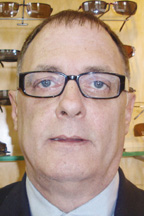 |
| Bruce Kolkmann |
Communication with the patient is of prime importance, especially with a first time progressive lens wearer, said Joan Rutka, optician at Mission Optical in Homewood, Ill. “Finding out what their needs are and fine tuning that to the right progressive lens is key.”
Rutka, who is in a medical practice with E. Michael Cassidy, MD, says offering a premium PAL is a good relationship builder. “It emphasizes the relationship between a person and their optician.”
Rutka says that she does not use any new diagnostic equipment but relies on recognizing needs and concerns and picking a lens that patients might benefit most from--and presenting that lens in lay terms.
Measuring IndividualEye/Head Movement
The Varilux Ipseo is positioned as a personalized progressive lens design that incorporates one’s physiological behavior into the lens surfacing, along with an optical Rx. Varilux recommends five steps in the fitting process of the Ipseo: taking monocular measurements, pre-adjusting the frame, measuring fitting height, verifying cut-out, and finally verifying proper fabrication and fit. Physical movement of a wearer’s head and eyes are scanned and measured with Varilux’s VPS (Vision Print System), a hand-held digital device. This step produces a head/eye ratio and sorts out an “eye mover” from a “head mover.”
An eye mover uses a greater percentage of the lens while a head mover will stay in central channel of the lens, explained Kirk Harris, OD, of Doctor’s Vision Center in Washington, N.C. Harris was an early proponent of the lens and has been successful for a year and a half in presenting this as a lens that offers personalized vision.
 |
| Kirk Harris, OD |
“Patients dislike having to point their head,” he said. “Patients have adapted but not enjoyed that older style of lens. In my experience, it’s wonderful for those people who can just put it on and not feel limited.”
To underscore the personalized nature of the Varilux Ipseo lens, the wearer’s initials are engraved on the lens itself.
“I use common world comparisons that most people experience every day,” said Harris, who believes in educating and not just selling his patients. “I explain that this is a lens built to your specifications, in the same way that a car can have settings just for you.”
Carl Zeiss Vision (CZV) also takes a high-tech approach to measuring patients for PALs. Last month at International Vision Expo East, CZV introduced the latest version of its Eye-Terminal, a patient fitting, measurement and consultation device. Eye-Terminal employs a precision digital camera, a computerized measuring system and a patented laser speckle-target system that assures proper distance fixation by the patient. Eye-Terminal automatically takes all progressive lens fitting measurements to an accuracy of 0.1mm. At the same time, it takes all measurements needed to create advanced customized progressives using direct surface manufacturing, including back vertex distance, pantoscopic angle and frame wrap. Eye-Terminal’s consultation module allows patients to see how they look in their chosen frames, and offers interactive demonstrations of lens enhancements.
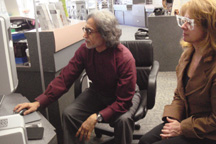 |
| Optician Paul Dimos uses the Zeiss Eye-Terminal to measure a patient for glasses. |
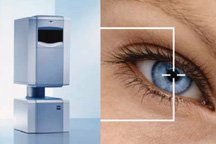 |
Paul Dimos, an optician who owns Eye Look Off Lexington in Lexington, Mass. has been using the Eye-Terminal for the past two-and-a-half years.
“It’s a great unit,” said Dimos. “I’m a believer that in order to take proper measurements, you need a device like this. A standard pupilometer is accurate for taking PDs, but not for dotting lenses. Eye Terminal gives you all vertical, height, monocular PD and total PD. It also has the capability of measuring vertex distance, distance of eye to lens, curve of frame and pantoscopic tilt. There is a menu, depending on what lenses you’re using--bifocals, trifocals, progressives, single-vision or aspheric lenses. It’s very accurate for aspheric lenses which must be fitted a certain way. You can’t put the lens smack against the cornea with an aspheric. The distance has to be calculated, and this unit does the calculation for aspheric and atoric lenses.”
Dimos also likes other features of the unit, such as its ability to demonstrate the difference between bifocals and PALs and AR lenses and non-AR lenses as well as the ability to display tinted and photochromic lenses.
“It’s a complete solution,” said Dimos. “From a technical point-of-view, it is very accurate. I also like that it’s impressive to clients. You can walk them through the measuring steps, and other patients see we have the latest technology. All measurements are computerized. At the end, we dispense Zeiss lenses, which is what we mainly use. The patients can see the difference in the whole process for selecting the frames and lenses.” Upon dispensing the patient’s eyeglasses, Dimos provides them with a print out generated by the Eye-Terminal which includes the patient’s photo and all the measurement details.
Indo Lens U.S. also offers a system that allows ECPs to measure each patient’s “visual strategy,” which the company defines as “a coordinated set of eye and head movements that come into play when performing a visual activity.” The system employs Indos’ proprietary Visual Map technology.
Ophthonix, a relatively new player in the PAL market, takes a different approach to patient measurements. In order to prescribe Ophthonix’s iZon PAL, optometrists must use the company’s proprietary Z-View aberrometer to evaluate low- and high-order aberrations. These captured data, including the high-order aberration measurements of spherical aberration, coma, and trefoil, are transmitted to the Ophthonix lab where the lens is laser generated. This information can be sent to the lab electronically, or faxed or sent as hard copy.
Brian Chou, OD, of Carmel Mountain Vision Care in San Diego, reports good patient response to the Ophthonix iZon High Resolution Progressive lens. As with the single-vision iZon lens that the practice has fit for several years, patients respond well to the “high definition” clarity of the PAL lens optics. The company claims to make each lens to the “ocular fingerprint” of the individual wearer.
 |
| Brian Chou |
“Both iZon lenses attempt to correct higher order aberrations of the eye,” said Chou, “and it’s a real point of distinction from using wavefront technology to only control inherent aberrations of the spectacle lens.”
The iZon progressive works well on patients that fall within the available parameter range of -6.00 to +4.00D sphere with up to -4.00D cylinder and up to a +3.50 add, according to Chou. The practice charges a $100 to $200 premium over other high-end PAL lenses. The iZon lenses are generated in a 1.6 high-index material with a full complement of lens treatments. “It’s a premium lens for patients who want the very best,” Chou noted.
Observing Body Movements
Observing head and eye movements may be second nature for a good optician. “Any dispenser should observe head movement automatically as part of the regular criteria,” said Tiernan. “Consider their height and posture, how they’re using their eyes and what applications they’re using their glasses for.
“If someone has stooped posture or a dropped chin, we know we have to raise the mid and reading section of lens,” he said. “They may require a single vision lens for intermediate, depending on Rx needs. We’ve been doing it so long it’s second nature. For entry-level dispensers, they need to learn those things. They need to ask questions and be observant.”
And there are times when an optician must steer a customer away from a frame choice that won’t accommodate the advantages of premium PAL features.
“Customers often pick out frames that won’t work well with progressives, and I tell them so,” said Binkowitz. “I say ‘I’d be happy to take your money but you won’t like what I make,’ and they say, ‘Show me what will.’”
Manufacturer Information Helpful
Consumer information from manufacturers can be helpful in both explaining a new PAL design and in assuring a wearer that they are getting a host of cutting-edge benefits that justify a premium price.
“Before a new progressive wearer leaves, I give them the product information brochure,” said Bregman. “If they’re wearing a premium lens, I want them to know what they’ve got and all the advantages. If someone else says they also got progressives and they paid less, I want them to be able to know the premium aspects so they’re comparing apples and oranges.”
Still, Bregman said that most manufacturer-supplied brochures have room for improvement. “They have pretty pictures, but they’re probably written by someone at an ad agency who never fit a pair of progressives.”
At Fortney Eyecare stores in southeast Michigan, information pieces like a desk blotter than details the benefits of PALs are helpful. By doing a good job of presenting premium PALs, opticians can achieve a higher level of compliance and easy adaptability and have fewer redoes than ever before, said president Bill Fortney.
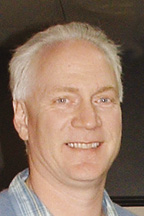 |
| Bill Fortney |
“We feel you’re going to get better clarity with a premium lens that’s state of the art,” said Fortney. “You’ll be happier wearing that lens and have a better and wider viewing area.”
At Fortney Eyecare, opticians often fit the Kodak Unique from Signet Armolite as well as the Essilor Definity. “These are high-end lenses for us, with AR coating, all the lens treatments, all the bells and whistles,” said Fortney. “You have to present the benefits if the sale is $50 to $70 more, and people are paying $275 for lenses.”
Specialty PAL Fits
The latest generation of PALs also allows for specialty fitting, which often delights wearers. For presbyopes with heavy computer usage, Binkowitz fits the Shamir Office PAL, which appeals to users with its larger reading segment.
“It’s like an easy-to-wear sneaker in a six-foot world,” said Binkowitz, who added that wearers of the Office lens almost universally also have a pair of Varilux Comfort lenses for other life tasks. Priced as a package with a special frame for $249 complete, it’s an easy sell, said Binkowitz. “Every patient we fit with the Shamir Office comes back and thanks us.”
Not for All Practices or Retail Outlets
Latest technology PALs do not yet fit every practice or retail venue. Wavefront or freeform lens designs are not offered at Optical Outlets, a 37-office chain in central and western Florida. However, president Robert Lewenson, OD, says he is open to new technology and meets regularly with manufacturer reps to discuss new designs and materials.
“Our patients are price sensitive,” Lewenson explained. He offers, as a special package, complete pairs of eyeglasses with PAL lenses for $99.99, though there are premium lens options going up from there. At present, his stores fit 100 to 200 progressive lens spectacles each day, most often the Vision-Ease Outlook or the Essilor Natural.
Lewenson envisions a time when wavefront and freeform technology in PALs will be commonplace, and he is acquiring new equipment in anticipation of that. “We just bought a new lens generator from Gerber [Coburn] that has capacity to do freeform,” he said. “We’re not yet doing wavefront, but one day you’ll be buying lens blanks from a manufacturer and be manufacturing your own progressives, and we’ll be set up for that.”
Better Vision Ahead
As the latest generation of PALs is being accepted by dispensers and wearers, the day is rapidly approaching when an even higher level of vision may be possible.
“Laser vision correction has driven this technology,” said Kolkmann. He added that with the aid of a computer, a lens designer can design pretty much anything, but the manufacturing process lags behind--at least for now. “They’re already on their way to a truly more individualized lens with more usable areas throughout the whole lens surface.”
--With contributions from Andrew Karp, group editor, lenses and technology